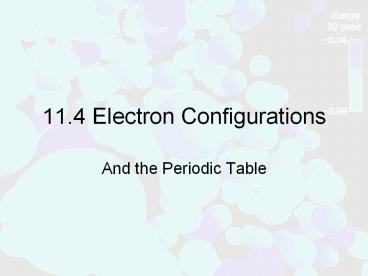11.4 Electron Configurations - PowerPoint PPT Presentation
Title: 11.4 Electron Configurations
1
11.4 Electron Configurations
- And the Periodic Table
2
11.4 Electron Configurations (p377)
- The electron configuration of hydrogen is 1s1
- This means there is one electron in the 1s
orbital.
3
11.4 Electron Configurations
- Rule 1 Electrons occupy the lowest orbital
energies first.
2p
Energy
2s
Then here
1s
First here
4
11.4 Electron Configurations
- Rule 2 Pauli Exclusion Principle Two electrons
can occupy the same orbital. - They have different spins
2p
Energy
2s
1s
One
Two
5
11.4 Electron Configurations
- Rule 3 Electrons will not pair up in the same
orbital until all energy levels are occupied.
2p
Energy
2s
1s
6
Example Sodium (Na)
- Start by drawing a dashed line for each
sub-orbital needed in the correct order.
1s
3s
2px
2s
2py
2pz
7
11.4 Electron Configurations
- Look at your field diagram
- The order of the seats is the same as the order
of orbitals. - Notice the 4th energy level has seats closer than
some of the 3rd energy level. - Which orbital fills up first, 4s or 3d?
- Yes, 3d.
8
(No Transcript)
9
Electron Configuration
- Quicker way to write the orbital notation
- Example sodium
- Becomes 1s22s22p63s1
1s
3s
2px
2s
2py
2pz
10
11.4 Electron Configurations
- Examples Li (Z3), N (7), O(8) (See book)
- Mg can be written as Ne3s2
- Valence electrons are the electrons in the
highest principal energy level of an atom. They
are involved in bonding with other atoms. - Nitrogen has electrons in n 1 and 2. Level 2
is the valence level. 1s22s22p3 - Nitrogen has 5 valence electrons.
11
11.4 Electron Configurations
- The core electrons are the inner electrons, and
are not involved in bonding. - Question What elements have the same number of
valence electrons as N? - Where are they on the periodic table?
- Elements with the same number of valence
electrons have similar chemical properties.
12
B. Electron Configurations and the Periodic Table.
Helium actually part of s-block
1
2
s-block
3
p-block
d-block Number one less than row number
4
5
6
7
f-block Number two less than row number
13
Example Germanium (Ge)
- Do the orbital notation
1s
2s
2p
2p
2p
3s
3p
3p
3p
4s
3d
3d
3d
3d
3d
4p
4p
4p
14
11.4 C. Atomic Properties and the Periodic Table
- Representative Elements - groups 1A-8A
- Ionization ionization is when an atom loses an
electron. - Remember ______________ lose electrons.
- _______________ gain electrons.
- Going down a group, atoms are more likely to lose
an electron. Cs is more likely to lose an
electron than Li.
Metals
Nonmetals
15
11.4 C. Atomic Properties and the Periodic Table
- Atomic size decreases going up and right.
- Decreases going up because electrons are closer
at lower principal energy levels. - Decreases going right because the charge in the
nucleus is stronger.
16
Atomic Size
- Size generally decreases
- Size generally decreases
17
11.4 C. Atomic Properties and the Periodic Table
- Ionization energy - the energy required to remove
an electron from an atom in the gas phase. - increases up a group
- increases to the right
18
Ionization Energy
- Increases
- increases
19
Checkpoint
- Which element has a larger atomic size?
- Sulfur or chlorine?
- Answer Sulfur
- Which element has the larger ionization energy?
- Sodium or potassium?
- Answer Sodium
- http//www.mhhe.com/physsci/chemistry/essentialche
mistry/flash/atomic4.swf - http//video.google.com/videoplay?docid-213426665
4801392897































